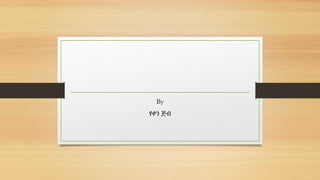Attachment
•Download as PPTX, PDF•
0 likes•61 views
This document provides information on calculating estimated blood volume and allowable blood loss for patients. It discusses that estimated blood volume is calculated as body weight in kg multiplied by average blood volume per kg for a person's age and sex. Allowable blood loss is calculated as estimated blood volume multiplied by the difference between initial and minimum acceptable hemoglobin levels, divided by the initial hemoglobin level. The document also discusses guidelines for replacing blood loss with fluids or transfusions to maintain appropriate hemoglobin and hematocrit levels.
Report
Share
Report
Share

Recommended
Recommended
More Related Content
Similar to Attachment
Similar to Attachment (20)
Blood Component Therapy: What a clinician needs to know !

Blood Component Therapy: What a clinician needs to know !
More from simegnewyismaw
More from simegnewyismaw (13)
Anaesthetic airway equipment and infection control

Anaesthetic airway equipment and infection control
Anaesthesia for patients_with_liver_disease_ceaccp_2010

Anaesthesia for patients_with_liver_disease_ceaccp_2010
Recently uploaded
Mehran University Newsletter is a Quarterly Publication from Public Relations OfficeMehran University Newsletter Vol-X, Issue-I, 2024

Mehran University Newsletter Vol-X, Issue-I, 2024Mehran University of Engineering & Technology, Jamshoro
Recently uploaded (20)
Presentation by Andreas Schleicher Tackling the School Absenteeism Crisis 30 ...

Presentation by Andreas Schleicher Tackling the School Absenteeism Crisis 30 ...
Seal of Good Local Governance (SGLG) 2024Final.pptx

Seal of Good Local Governance (SGLG) 2024Final.pptx
Z Score,T Score, Percential Rank and Box Plot Graph

Z Score,T Score, Percential Rank and Box Plot Graph
Asian American Pacific Islander Month DDSD 2024.pptx

Asian American Pacific Islander Month DDSD 2024.pptx
ICT Role in 21st Century Education & its Challenges.pptx

ICT Role in 21st Century Education & its Challenges.pptx
Basic Civil Engineering first year Notes- Chapter 4 Building.pptx

Basic Civil Engineering first year Notes- Chapter 4 Building.pptx
This PowerPoint helps students to consider the concept of infinity.

This PowerPoint helps students to consider the concept of infinity.
Energy Resources. ( B. Pharmacy, 1st Year, Sem-II) Natural Resources

Energy Resources. ( B. Pharmacy, 1st Year, Sem-II) Natural Resources
Ecological Succession. ( ECOSYSTEM, B. Pharmacy, 1st Year, Sem-II, Environmen...

Ecological Succession. ( ECOSYSTEM, B. Pharmacy, 1st Year, Sem-II, Environmen...
Attachment
- 1. By የቀን ጅብ
- 2. Maximum ABL calculation • Definition • EBV calculation: body wt (kg) x average blood volume (ml/kg) • ABL= [EBV x (Hi-Hf)]/Hi • Where: • EBV=Estimated Blood Volume • Hi= initial hemoglobin • Hf= final hemoglobin
- 3. Average blood volumes Premature Neonates 95 mL/kg Full Term Neonates 85 mL/kg Infants 80 mL/kg Adult Men 75 mL/kg Adult Women 65 mL/kg Normal Hct Values Men 42-52% Women 37-47% • If the patient is obese, using the IBW or ABW will give more accuracy than an actual weight.
- 4. • Example Question: Before surgery is to take place, what is the estimated blood volume (EBV) of a female patient weighing 50 kg? Also, what is the allowable blood loss (ABL) of this patient if her Hct is 45? In the example above, EBV = 50kg x 65 (adult woman’s blood volume) = 3250 The initial Hct (Hi) = 45%, her current Hct The final lowest acceptable Hct (Hf) = 30% (What ever cut off is used clinically to decide how low the individual’s Hct will be allowed to drop. Thirty percent is used in this calculator but in reality this will vary from case to case.) So the example would look like this: • (3250 x (45 – 30))/45 = 1083 Using this rough estimate, the patient in this example could loose 1083 mL of blood without needing a transfusion.
- 5. Replacing Blood Loss Ideally, blood loss should be replaced with crystalloid or colloid solutions to maintain intravascular volume (normovolemia) until the danger of anemia outweighs the risks of transfusion. At that point, further blood loss is replaced with transfusions of red blood cells to maintain hemoglobin concentration (or hematocrit) at that level. For most patients, that point corresponds to a hemoglobin between 7 and 10 g/dL (or a hematocrit of 21-30%). Below a hemoglobin concentration of 7 g/dL, the resting cardiac output has to increase greatly to maintain normal oxygen delivery”
- 6. Estimating blood loss • Dry sponges 4×4 hold ~ 10 mL blood Ray-techs ~ 10-20 mL blood Lap sponges ~ 50-100 mL blood
- 7. Pediatric cases should have sponges & gauze weighed for blood loss Blood loss replacement • Replace 1 mL blood with: i. 3 mL crystalloid (i.e. NS, Dextrose, LR) ii. 1 mL colloid (i.e. albumin**, Hespan®, Dextran®) iii. 1 mL whole blood iv. 1 mL PRBC